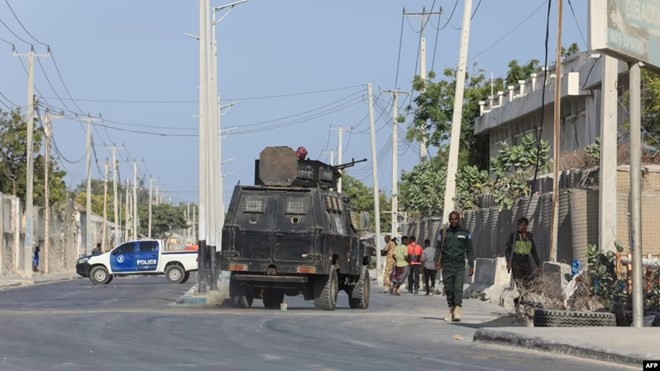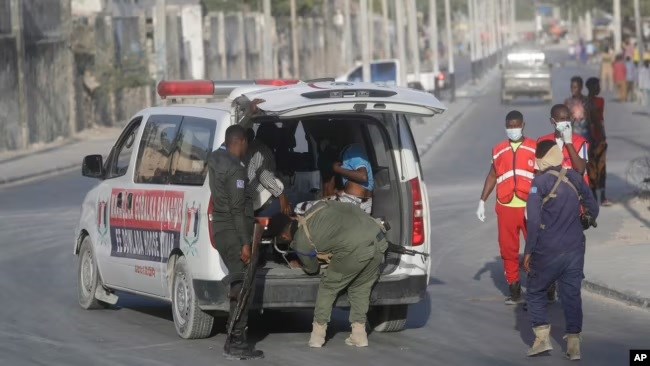
Wednesday March 15, 2023
By Harun Maruf

FILE - Security forces patrol outside a building that was attacked by suspected al-Shabab militants in the Somalia's capital Mogadishu on Feb. 21, 2023.
Somali officials are warning the federal and regional governments of Somalia not to underestimate the strength of militant groups al-Shabab and Islamic State as authorities plan new military operations against them.
Despite recent successes in dislodging al-Shabab from vast countryside areas in central Somalia, the militant group hit back, setting off deadly explosions and raiding military bases and installations, killing dozens.
advertisements
In the latest attack Tuesday, an al-Shabab suicide car bomb targeted a building housing regional officials who have been planning mobilizations against al-Shabab in the town of Bardhere, Gedo region. The attack killed four soldiers and injured nine others.On March 7, al-Shabab raided a military base at Janaa Cabdalle village, killing at least five soldiers.
Somali officials warn that al-Shabab’s militia strength is “intact,” and they argue recent operations did not substantially weaken the group’s strength.
“I believe on one hand they have been slightly wounded, but their strength remains intact,” said two-time former Prime Minister Omar Abdirashid Ali Sharmarke. “They have been making tactical retreats lately, but their force cannot be underestimated.”
Mohamed Abdi Tall, the governor of Bakool region, which is planning to join the second phase of the offensive, says the group is particularly entrenched in the southern Jubaland and Southwest regions.

FILE - Security carry away victims injured during fighting between al-Shabab extremists and soldiers in Mogadishu, Somalia, Feb. 21, 2023.
Tall said the country is large and it will require support from the federal government and volunteers to participate in the operations against al-Shabab.
He argues that al-Shabab has been building and recruiting for years and has a larger force than reported previously. He estimates that al-Shabab had “not less than 20,000 fighters” before last year’s military offensive started.
“For 15 years they have been recruiting, they readied lots of fighters,” he said. “They had lots of power. Since they have been removed from regions, we assess their strength has been destroyed, but we are not underestimating them.”
Hussein Sheikh-Ali, the national security adviser to the president of Somalia, gave a lower number for al-Shabab's fighting personnel. “My assessment, plus or minus, is they are 10,000,” he said. “The last estimate I had couple of years ago was 14,000, but since then I don’t believe they have trained adequate numbers, and they have been involved in too many fights.”
Ali said he believes al-Shabab lost “more than a thousand” fighters within the past six months and “probably would have 2,000-3,000 injured” as a result of the military operations.
Ali insists the government itself is not underestimating al-Shabab.
“I have been somebody who always, when people were underestimating Shabab, used to warn people not to underestimate them,” he said. “But now, because they have no support from the population, their days are numbered.”
IS threat
In the remote mountains of northeastern Somalia, al-Shabab and Islamic State militants clashed this week, the latest in multiple skirmishes between the sides over the control and influence of the Cal-Miskaad highlands since late 2018.
Somalia’s IS contingent, which is smaller in size than al-Shabab, still poses a “great danger” to Somalia, experts said.
Founded by Sheikh Abdulkadir Mumin, who defected from al-Shabab in 2015, the group members occupy a small territory in the eastern parts of the semi-autonomous Puntland region.
Ahmed Mohamoud Yusuf, commissioner of Balidhidhin, a frontline district in Puntland, told VOA that IS militants have been recruiting Ethiopian fighters in recent years.
He said when the group first arrived in the area in 2015 and 2016 their numbers were estimated to be about 20 fighters. That number rose to 250 to 300 fighters, including Ethiopians, according to regional experts.
“It’s not easy to say exact figure,” Yusuf said when asked about the number of Ethiopian fighters.
The number of Ethiopian fighters is believed to be significant, and IS has previously released a propaganda video showing Ethiopians among its ranks.
“ISIS has always targeted Ethiopia and other African states for recruits, its main limitation is that its physical presence is limited to a very small district in northern Somalia east of Bosaso, where it has almost no vegetation, limited cover,” said Matt Bryden, Horn of Africa regional analyst.
“It moves its fighters between caves and settlements and cannot establish a viable operational presence. So however much it tries to recruit from across the continent, it really doesn't have a solid base from which to project influence and power.”
Bryden believes al-Shabab is further ahead of IS in its regional reach, including recruiting Ethiopian fighters.
Yusuf said Puntland has been fighting IS since the militants arrived in the area and has prevented them from seizing control of an urban area.
The strategic location of the group’s hideout, which includes caves, poses danger to Puntland and Somalia, according to Sharmarke.
“Definitely these people will surprise us one day unless they are put under pressure and hunted down,” he said.
Sharmarke called for cooperation and intelligence sharing between Puntland, other states and the federal government of Somalia.
U.S. hails killing of IS leader
IS-Somalia recently came under the spotlight following the killing of one of its top foreign fighters, Bilal al-Sudani, in a special operation by U.S. forces in Cal-Miskaad mountains. The U.S. hailed the killing of al-Sudani in the January 26 counterterrorism operation.
The U.S. described him as a “key operative and facilitator for ISIS global network, as well as a number of other ISIS operatives.”
An IS defector who declined to be identified for security reasons told VOA that al-Sudani was not only the group’s finance operative but its number two leader behind the emir, Mumin.
Al-Sudani, real name Suhayl Salim, arrived in Somalia in 2006 along with his brother, Suhayb, seeking jihad in Somalia, defectors said. That is the year Islamic courts took over most of south central Somalia and defeated U.S.-backed warlords.
Omar Mohamed Abu Ayan, a former al-Shabab official, said Al-Sudani had a twin brother who died in 2008 after a mortar he was firing at the Somali presidential palace in Mogadishu malfunctioned and exploded on him.
Abu Ayan said al-Sudani had a role in the recruitment of Ethiopians.
“He came up with the idea to translate Daesh propaganda into Amharic, targeting Ethiopia,” Abu Ayan said.
Despite its limitations, IS-Somalia has enjoyed a “disproportionate influence” within Islamic State networks from Somalia to the Democratic Republic of Congo, Kenya, Uganda and down to Mozambique in southern Africa, analyst Bryden said.